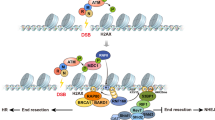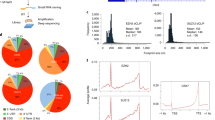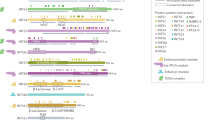Abstract
With the recent recognition of non-coding RNAs (ncRNAs) flanking many genes1,2,3,4,5, a central issue is to obtain a full understanding of their potential roles in regulated gene transcription programmes, possibly through different mechanisms6,7,8,9,10,11,12. Here we show that an RNA-binding protein, TLS (for translocated in liposarcoma), serves as a key transcriptional regulatory sensor of DNA damage signals that, on the basis of its allosteric modulation by RNA, specifically binds to and inhibits CREB-binding protein (CBP) and p300 histone acetyltransferase activities on a repressed gene target, cyclin D1 (CCND1) in human cell lines. Recruitment of TLS to the CCND1 promoter to cause gene-specific repression is directed by single-stranded, low-copy-number ncRNA transcripts tethered to the 5′ regulatory regions of CCND1 that are induced in response to DNA damage signals. Our data suggest that signal-induced ncRNAs localized to regulatory regions of transcription units can act cooperatively as selective ligands, recruiting and modulating the activities of distinct classes of RNA-binding co-regulators in response to specific signals, providing an unexpected ncRNA/RNA-binding protein-based strategy to integrate transcriptional programmes.
This is a preview of subscription content, access via your institution
Access options
Subscribe to this journal
Receive 51 print issues and online access
$199.00 per year
only $3.90 per issue
Buy this article
- Purchase on Springer Link
- Instant access to full article PDF
Prices may be subject to local taxes which are calculated during checkout





Similar content being viewed by others
References
Kapranov, P., Willingham, A. T. & Gingeras, T. R. Genome-wide transcription and the implications for genomic organization. Nature Rev. Genet. 8, 413–423 (2007)
Bernstein, E. & Allis, C. D. RNA meets chromatin. Genes Dev. 19, 1635–1655 (2005)
Carninci, P. et al. The transcriptional landscape of the mammalian genome. Science 309, 1559–1563 (2005)
Bertone, P. et al. Global identification of human transcribed sequences with genome tiling arrays. Science 306, 2242–2246 (2004)
Mattick, J. S. & Makunin, I. V. Non-coding RNA. Hum. Mol. Genet. 15 (Spec. Iss. 1) R17–R29 (2006)
Martianov, I., Ramadass, A., Serra Barros, A., Chow, N. & Akoulitchev, A. Repression of the human dihydrofolate reductase gene by a non-coding interfering transcript. Nature 445, 666–670 (2007)
Rinn, J. L. et al. Functional demarcation of active and silent chromatin domains in human HOX loci by noncoding RNAs. Cell 129, 1311–1323 (2007)
Feng, J. et al. The Evf-2 noncoding RNA is transcribed from the Dlx-5/6 ultraconserved region and functions as a Dlx-2 transcriptional coactivator. Genes Dev. 20, 1470–1484 (2006)
Petruk, S. et al. Transcription of bxd noncoding RNAs promoted by Trithorax represses Ubx in cis by transcriptional interference. Cell 127, 1209–1221 (2006)
Sanchez-Elsner, T., Gou, D., Kremmer, E. & Sauer, F. Noncoding RNAs of trithorax response elements recruit Drosophila Ash1 to Ultrabithorax. Science 311, 1118–1123 (2006)
Lanz, R. B. et al. A steroid receptor coactivator, SRA, functions as an RNA and is present in an SRC-1 complex. Cell 97, 17–27 (1999)
O’Neill, M. J. The influence of non-coding RNAs on allele-specific gene expression in mammals. Hum. Mol. Genet. 14 (Spec. Iss. 1) R113–R120 (2005)
Rosenfeld, M. G., Lunyak, V. V. & Glass, C. K. Sensors and signals: a coactivator/corepressor/epigenetic code for integrating signal-dependent programs of transcriptional response. Genes Dev. 20, 1405–1428 (2006)
McKenna, N. J. & O’Malley, B. W. Combinatorial control of gene expression by nuclear receptors and coregulators. Cell 108, 465–474 (2002)
Seo, S. B. et al. Regulation of histone acetylation and transcription by INHAT, a human cellular complex containing the set oncoprotein. Cell 104, 119–130 (2001)
Sebastiaan Winkler, G. et al. Isolation and mass spectrometry of transcription factor complexes. Methods 26, 260–269 (2002)
Uranishi, H. et al. Involvement of the pro-oncoprotein TLS (translocated in liposarcoma) in nuclear factor-κB p65-mediated transcription as a coactivator. J. Biol. Chem. 276, 13395–13401 (2001)
Yang, L., Embree, L. J., Tsai, S. & Hickstein, D. D. Oncoprotein TLS interacts with serine-arginine proteins involved in RNA splicing. J. Biol. Chem. 273, 27761–27764 (1998)
Hicks, G. G. et al. Fus deficiency in mice results in defective B-lymphocyte development and activation, high levels of chromosomal instability and perinatal death. Nature Genet. 24, 175–179 (2000)
Kuroda, M. et al. Male sterility and enhanced radiation sensitivity in TLS-/- mice. EMBO J. 19, 453–462 (2000)
Baechtold, H. et al. Human 75-kDa DNA-pairing protein is identical to the pro-oncoprotein TLS/FUS and is able to promote D-loop formation. J. Biol. Chem. 274, 34337–34342 (1999)
Bertrand, P., Akhmedov, A. T., Delacote, F., Durrbach, A. & Lopez, B. S. Human POMp75 is identified as the pro-oncoprotein TLS/FUS: both POMp75 and POMp100 DNA homologous pairing activities are associated to cell proliferation. Oncogene 18, 4515–4521 (1999)
Ron, D. TLS-CHOP and the role of RNA-binding proteins in oncogenic transformation. Curr. Top. Microbiol. Immunol. 220, 131–142 (1997)
Kurokawa, R. et al. Differential use of CREB binding protein-coactivator complexes. Science 279, 700–703 (1998)
Lerga, A. et al. Identification of an RNA binding specificity for the potential splicing factor TLS. J. Biol. Chem. 276, 6807–6816 (2001)
Miyakawa, Y. & Matsushime, H. Rapid downregulation of cyclin D1 mRNA and protein levels by ultraviolet irradiation in murine macrophage cells. Biochem. Biophys. Res. Commun. 284, 71–76 (2001)
Impey, S. et al. Defining the CREB regulon: a genome-wide analysis of transcription factor regulatory regions. Cell 119, 1041–1054 (2004)
Murata, T. et al. Defect of histone acetyltransferase activity of the nuclear transcriptional coactivator CBP in Rubinstein–Taybi syndrome. Hum. Mol. Genet. 10, 1071–1076 (2001)
Agami, R. & Bernards, R. Distinct initiation and maintenance mechanisms cooperate to induce G1 cell cycle arrest in response to DNA damage. Cell 102, 55–66 (2000)
Korzus, E. et al. Transcription factor-specific requirements for coactivators and their acetyltransferase functions. Science 279, 703–707 (1998)
Acknowledgements
We thank A. Gettings for help with mass spectrometric analysis; M. Hiramatsu, W. Sato and C. Nelson for technical assistance; A. Matsushita, M. Matsubara and T. Oyoshi for discussion; and J. Hightower and M. Fisher for figure and manuscript preparation. This work was supported by the Fujisawa Foundation, the Takeda Science Foundation, the Naito Foundation, Sankyo Foundation Life Science, and grants-in-aid (nos 17054036 and 18055029) from the Ministry of Education, Culture, Sports, Science, and Technology in Japan to R.K., by National Institutes of Health grants CA52599 and HL59694 to C.K.G., by National Cancer Institute Cancer Center Support grant P30 CA08748 to P.T., by NS34934, DK39949 and CA097134 to M.G.R., and by DK074868 to C.K.G. and M.G.R. M.G.R. is a Howard Hughes Medical Institute investigator.
Author information
Authors and Affiliations
Corresponding authors
Supplementary information
Supplementary information
The file contains Supplementary Figures S1-S16 with Legends. (PDF 17970 kb)
Rights and permissions
About this article
Cite this article
Wang, X., Arai, S., Song, X. et al. Induced ncRNAs allosterically modify RNA-binding proteins in cis to inhibit transcription. Nature 454, 126–130 (2008). https://doi.org/10.1038/nature06992
Received:
Accepted:
Published:
Issue Date:
DOI: https://doi.org/10.1038/nature06992
This article is cited by
-
LINC00571 drives tricarboxylic acid cycle metabolism in triple-negative breast cancer through HNRNPK/ILF2/IDH2 axis
Journal of Experimental & Clinical Cancer Research (2024)
-
LINC00955 suppresses colorectal cancer growth by acting as a molecular scaffold of TRIM25 and Sp1 to Inhibit DNMT3B-mediated methylation of the PHIP promoter
BMC Cancer (2023)
-
lncRNA-FMR6 directly binds SAV1 to increase apoptosis of granulosa cells in premature ovarian failure
Journal of Ovarian Research (2023)
-
ncDENSE: a novel computational method based on a deep learning framework for non-coding RNAs family prediction
BMC Bioinformatics (2023)
-
CPPVec: an accurate coding potential predictor based on a distributed representation of protein sequence
BMC Genomics (2023)
Comments
By submitting a comment you agree to abide by our Terms and Community Guidelines. If you find something abusive or that does not comply with our terms or guidelines please flag it as inappropriate.



